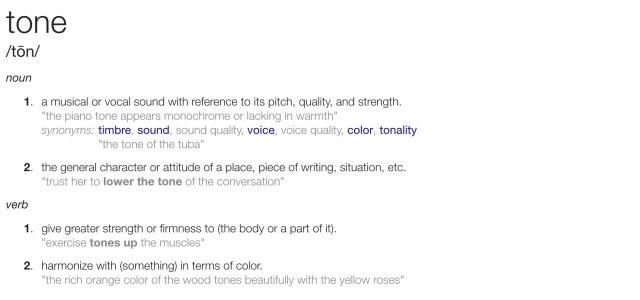Be humble. Be gentle. Be patient. Tolerate one another in an atmosphere thick with love.
Make every effort to preserve the unity the Spirit has already created, with peace binding you together.Ephesians 4:2-3 (The Voice Bible)
I often tell my children that what matters is not just what you say but how you say it. I remind them often that the way words are said, gestures, and posture communicate more than the words themselves. In other words that tone matters.

Tone reveals deeply what words alone could hide. Our true feelings come to the surface: our anxieties, fears, anger, and annoyance. Tone also tells us if we are being heard and if the other person is truly present to us. In our social media world tone is revealed by the type of font we use (ALL CAPS ANYONE), #snark, sarcasm, and passive aggressive posting. All sending a clear signal that we are not seeing the other as beloved, as one who is the image of God, as one like us.
Tone betraying our character and our harmony with the other or the lack thereof.
As people of faith we are called to holiness of heart and life. Through grace God’s love begins to fill the recesses of our souls. God’s grace allowing us to integrate who we say we are, what we say we believe in, with how we respond to ourselves and the other.
My latest sermon series, Life Between the Lines, has introduced the rules of the Methodist societies, to a new generation of people. Last week we discussed why we needed such guides and this weekend we will be talking about the first rule: Do No Harm.
Attending General Conference has opened my eyes at the ways that our tone towards one another, especially in disagreement, is betraying a deeper issue in our life together. Our tone on the plenary microphone, on legislative committees, and on social media speaks to a lack of charity, suspicion, arrogance, harshness, lies, and a host of other behaviors that are contrary to the faith we proclaim and the values we claim.
Our tone mirroring the tone of today’s culture instead of modeling what an loving and respectful alternative looks like. An alternative where disagreement is welcomed, where mutual respect is practiced, and where the atmosphere is “thick with love.”
One of the things that the study of Latin American liberation theology has taught me is that we cannot use the tools of the oppressor to bring freedom. If we do then we become the oppressor in its next itineration without even recognizing it as such. True freedom, true liberation, comes only through the tools of the kingdom: charity, presence, humility, gentleness, and peace.
I am not sure what will happen next at this General Conference. What I do know is that I am committed more than ever to return to the congregation I love and shepherd and come alongside them as we practice and model what a Christlike conversations look like. What the harmony of disagreement in love looks like. What it means to be a people of integrity — a people who have integrated their thoughts, actions, and attitudes — in our conversations with one another and with the world. What it means to be a people who are being sanctified.

